
Chorizema, commonly known as flame peas, is a genus of flowering plants in the family Fabaceae and is endemic to Australia.

Gastrolobium sericeum is a flowering plant in the family Fabaceae. It is endemic to the south-west of Western Australia. It is a prostrate, low shrub with pendulous yellow, green, red or nearly black pea-flowers from spring to summer.
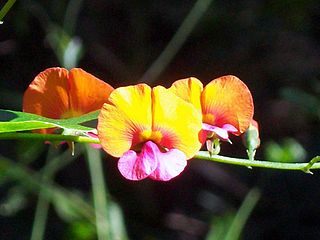
Chorizema cordatum, commonly known as heart-leaf flame pea, is a species of flowering plant in the family Fabaceae and is endemic to the southwest of Western Australia. Noongar people know the plant as kaly. It is a woody, erect, scrambling or climbing shrub with heart-shaped leaves, the flowers usually brightly coloured in yellow, orange and red.

Mirbelia baueri is a species of flowering plant in the family Fabaceae and is endemic to New South Wales. It is an erect or prostrate shrub with sharply-pointed linear leaves and orange and purple flowers.

Chorizema ilicifolium, commonly known as holly flame pea, is a species of flowering plant in the family Fabaceae and is endemic to the coast of southern Western Australia. It is a slender, erect to spreading shrub with prickly, egg-shaped to lance-shaped leaves and yellowish-orange and red pea flowers.

Bossiaea aquifolium, commonly known as water bush, nedik or netic, is a species of flowering plant in the pea family Fabaceae and is endemic to Southwest Australia. It is a slender shrub or small tree with egg-shaped leaves arranged in opposite pairs and yellowish flowers arranged singly or in pairs on the ends of branchlets.
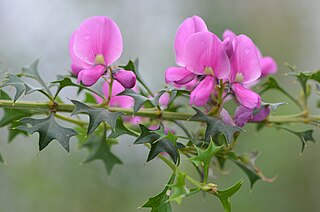
Mirbelia dilatata, commonly known as holly-leaved mirbelia, is a species of flowering plant in the family Fabaceae and is endemic to the south-west of Western Australia. It is an erect, bushy, shrub with prickly leaves and pink, purple or violet flowers.
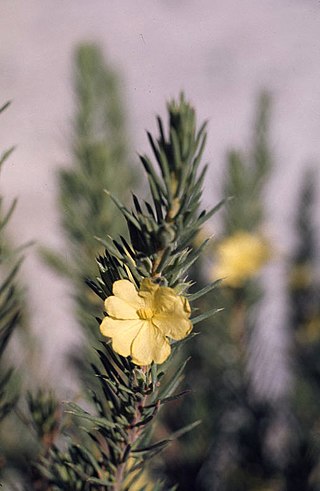
Hibbertia mucronata is a species of flowering plant in the family Dilleniaceae and is endemic to the south of Western Australia. It is an erect shrub with hairy branches, crowded, thick, tapering linear leaves ending in a sharp point, and golden yellow flowers with five stamens fused at their bases, all on one side of two densely hairy carpels.

Pultenaea rigida is a species of flowering plant in the family Fabaceae and is endemic to south-eastern South Australia. It is a rigid, erect to prostrate, much-branched shrub with lance-shaped, sharply-pointed leaves and yellow and red to purplish flowers.
Bossiaea saxosa is a species of flowering plant in the family Fabaceae and is endemic to a restricted area near Norseman, Western Australia. It is an erect, intricately branched shrub with many slightly flattened, sharply-pointed cladodes and deep yellow, red and lemon-yellow, pea-like flowers.

Pultenaea spinosa, commonly known as grey bush-pea or spiny bush-pea, is a species of flowering plant in the family Fabaceae and is endemic to south-eastern continental Australia. It is a low-lying to erect shrub with glabrous stems, egg-shaped to rhombic leaves, and yellow-orange and red, pea-like flowers.

Daviesia decurrens, commonly known as prickly bitter-pea, is a species of flowering plant in the family Fabaceae and is endemic to the south-west of Western Australia. It is spreading, erect, or low-lying shrub with scattered, sharply-pointed, narrow triangular phyllodes, and yellowish pink and velvety red flowers.
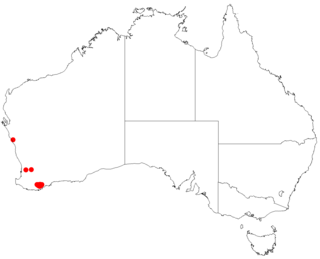
Leucopogon atherolepis is a species of flowering plant in the family Ericaceae and is endemic to the south-west of Western Australia. It is an erect shrub with linear leaves and white, tube-shaped flowers.

Chorizema parviflorum, commonly known as eastern flame pea, is a species of flowering plant in the family Fabaceae and is endemic to eastern Australia. It is an erect shrub with linear to narrowly egg-shaped leaves and yellow and reddish flowers arranged in racemes on the ends of branches.

Chorizema carinatum is a species of flowering plant in the family Fabaceae and is endemic to the southwest of Western Australia. It is an erect or spreading shrub with sharply-pointed leaves and bright yellow flowers.
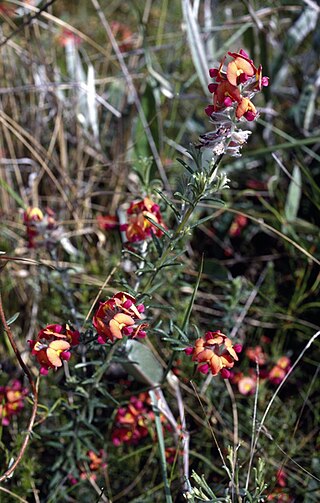
Chorizema cytisoides is a species of flowering plant in the family Fabaceae and is endemic to the southwest of Western Australia. It is an erect to low-lying or sprawling shrub with linear leaves and reddish-orange, yellow and purple flowers.
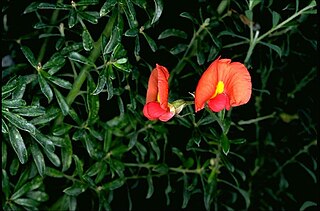
Chorizema dicksonii, commonly known as yellow-eyed flame pea, is a species of flowering plant in the family Fabaceae and is endemic to the southwest of Western Australia. It is an erect or spreading shrub with oblong to lance-shaped leaves and red and orange flowers.
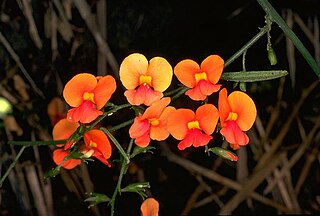
Chorizema diversifolium is a species of flowering plant in the family Fabaceae and is endemic to the southwest of Western Australia. It is a twining or trailing shrub or climber with variably-shaped, egg-shaped to narrowly lance-shaped leaves and pink, orange and red flowers.

Chorizema glycinifolium is a species of flowering plant in the family Fabaceae and is endemic to the south-west of Western Australia. It is a slender, erect or sprawling shrub with variably-shaped leaves and orange, pink or red flowers with yellowish markings.
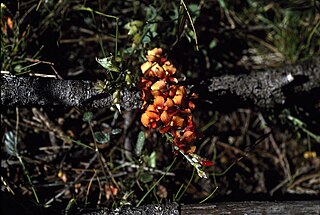
Chorizema humile is a species of flowering plant in the family Fabaceae and is endemic to the southwest of Western Australia. It is a sprawling, prostrate or low-lying shrub with egg-shaped or wedge-shaped leaves and yellow and reddish-brown flowers.



















